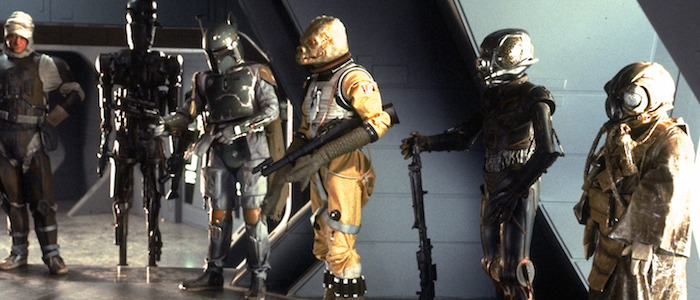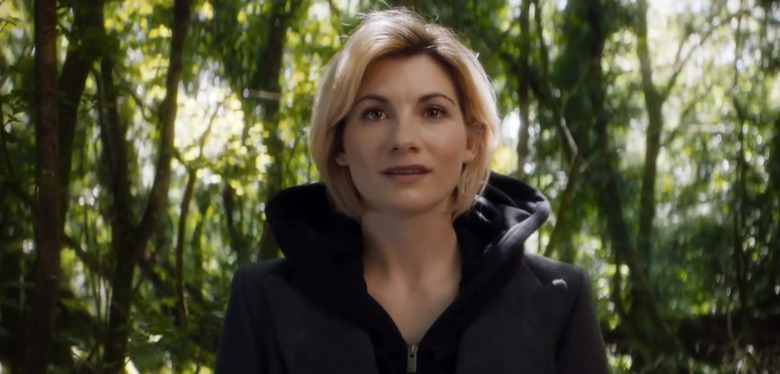Exploring The Many Connections Between 'Star Wars' And 'Doctor Who'
(Welcome to The Movies That Made Star Wars, a series where we explore the films and television properties that inspired or help us better understand George Lucas's iconic universe. In this edition: Doctor Who.)
There's a lot of crossover between Star Wars fans and Doctor Who fans. There's a lot to love about both franchises, but some might not know how closely the two franchises have intertwined from the beginning. Doctor Who began in its historic run in 1963, close to fifteen years before Star Wars would ever hit the big screen. Since both franchises were filmed largely in the United Kingdom, it's no wonder there would be some crossover in talent, but some might not realize how much crossover there really is.
For those Star Wars fans who don't know, Doctor Who is the longest running science fiction television series of all time and it's about a timelord who calls themselves the Doctor. They travel through all of time and space righting wrongs and saving the world. It's exactly the sort of thing Star Wars fans might love, and after you're done with this article, maybe you'll love it twice as much.
In Doctor Who: Doctor Who; Doctor Who and the Daleks (1965), and Daleks - Invasion Earth: 2150 AD (1966)
Grand Moff Tarkin, the man who destroyed billions on Alderaan, was the Doctor himself in another life. Peter Cushing, the actor behind Tarkin was cast as the Doctor in the big screen adaptations designed to bring Doctor Who to the world. It was actually the first time the Doctor appeared in widescreen and in color. Because Cushing was a more recognizable star, he got the part rather than William Hartnell who played the first iteration of the Doctor on television.
In Doctor Who: The 10th Doctor (2005-2010)
The Doctor is a character who regenerates into new bodies every time he's mortally wounded. For his tenth iteration, he regenerated into the body of David Tennant. Tennant played the Doctor regularly from 2005-2010, but few realize he actually won an Emmy award for playing a part in Star Wars. He was the voice behind Huyang, the droid responsible for helping younglings build their first lightsabers. It was probably not a coincidence that Huyang and the Doctor (during Tennant's tenure) were both well over 900 years old. He even helped Master Yoda construct his saber.
In Doctor Who: The Fourth Doctor (1974-1981)
Tom Baker might play one of the most enigmatic Doctors and characters in Star Wars alike. As the longest reigning Doctor, Tom Baker brought a bizarre humor to the part as well as an air of mischief and mystery. In Star Wars Rebels, he took on the part of the Bendu, a mysterious Force wielder on the planet of Atollon who is as much a Tom Bombadil-like creature as anything else.
In Doctor Who: The Eleventh Doctor (2010-2013)
The most recent Star Wars actor to have been involved in Doctor Who might be the eleventh Doctor himself. Matt Smith has been reported to have been cast in Star Wars: Episode IX. He spent three years as one of the most popular Doctors in the history of the show. Who or what he'll be playing in the next installment of the Star Wars saga is anyone's guess.
In Doctor Who: Scaroth; City of Death (1979)
Julian Glover, the man behind General Veers, is the sort of actor who's done everything. He was a bad guy to Indiana Jones, James Bond, the Stark family, and everyone in between, so it's no surprise he opposed the Doctor.
He played the villainous Scaroth in City of Death. This was a series of Doctor Who episodes starring Tom Baker as the fourth incarnation of the Doctor. It's a fan favorite arc, written by Douglas Adams (Hitchhiker's Guide to the Galaxy) and featuring a cameo from Monty Python's John Cleese. Glover is as menacing as Scaroth as Veers and his performance alone makes this bit of Doctor Who a must watch.
In Doctor Who: The Minotaur, The Time Monster (1972)
The third Doctor, Jon Pertwee, faced off against the body of Darth Vader in the 1972 Doctor Who story "The Time Monster." Like many roles David Prowse found himself in, though, he wasn't much more than a body. He played the Minotaur, a hulking human body beneath the mask of a giant bull. In the story, the Minotaur is the guardian of the Crystal of Kronos and he opposes the Doctor in any way he can. In Star Wars, Prowse obviously brought the physicality of Darth Vader to life in many of his most pivotal moments.
In Doctor Who: The Minotaur, The God Complex (2011); The Wooden King, The Doctor, the Widow, and the Wardrobe (2011); Skaldak, Cold War (2013)
Perhaps it was a prerequisite to play a minotaur in Doctor Who in order to be the body of Darth Vader and that's why Spencer Wilding was tasked with filling in for the Dark Lord in Rogue One. His first outing in Doctor Who was as a minotaur and he brought that same physicality to the role of Vader.
In Doctor Who: Tor, The Space Museum (1965); Hal the Archer, The Time Warrior (1973)
Boba Fett is a fan favorite character, and the original actor behind him, Jeremy Bulloch, has had two appearances in Doctor Who, though they were almost a decade apart. Bulloch's first appearance was opposite the first Doctor, William Hartnell, in "The Space Museum." He played the Xeron rebel, Tor, who fought the Morok invaders. Close to a ten years later, he played the servant of Lord Edward of Wessex in "The Time Warrior," opposite the third Doctor. This episode was notable as it was the first appearance of the war-mongering Sontarans.
Jeremy Bulloch, in an appearance on the Full of Sith podcast, talked about his time on Doctor Who in his own words. "When I joined with William Hartnell, he used to say, "Now, listen to me, son. Watch what I do, cause I know what I'm doing. How long have you been in this business?" And I said, "Seven years."
"Not long enough. Listen to what I'm saying. It's pretend. When you jump on me, it's pretend. You don't muck about. Pretend. You got to watch what you do.'
"I said, yes, Mr. Hartnell. "Anything else I can help you with?" I said, "No. I'm just going to watch what you do."
So we go through this thing and he goes, "No, no, no. Come on. Let's stop all this, you know. You're pushing me.'
"And I thought he was going to be very difficult, but then his last words at the end of that scene, he said, when we finished that scene, "Well done, son. You listened. You learned.' That was it."
In Doctor Who: Ky, The Mutants (1972); Abraham, A Town Called Mercy (2012)
Biggs Darklighter himself is notable on this list for being the only actor to appear in both the classic and modern eras of Doctor Who. Pre-dating his appearance in Star Wars by a few years, Hagon played Ky in a story of the third Doctor's called "The Mutants." More recently, he played Abraham, the undertaker in an episode during the eleventh Doctor's run. It was called "A Town Called Mercy" and he measured the Matt Smith for a coffin.
In Doctor Who: The Overseer; The Underwater Menace (1968)
Graham Ashley, the man behind the ill-fated Gold Five, played the Atlantean Overseer opposite Patrick Troughton, the second Doctor. It was in an episode called "The Underwater Menace," which certainly evokes the title of Episode I.
In Doctor Who: Sondergaard; The Mutants (1972)
You'll remember John Hollis as Lando Calrissian's faithful companion, Lobot. He played Professor Sondergaard in the Jon Pertwee era Doctor Who story, "The Mutants," alongside Garrick Hagon. His character worked to find a cure for the Solonians' mutations, before he realized that the mutation was a part of their natural life cycle.
In Doctor Who: Solana Mercurio; Planet of the Ood (2008)
Ayesha Dharker made her debut in Star Wars in Attack of the Clones as Queen Jamillia, but she crossed over to Doctor Who in 2008 to play opposite David Tennant's Doctor in the episode "Planet of the Ood." As Solana Mercurio, she worked in Ood Operations and eventually died at the hands of an Ood.
In Doctor Who: Solomon; Daleks in Manhattan, Evolution of the Daleks (2007)
Captain Panaka, played by Hugh Quarshie, is one of the coolest secondary characters in The Phantom Menace, tasked with balancing the wishes of the Jedi with the safety of the Queen. In Doctor Who he also played guardian, but instead of Naboo, he was a guardian of the residents of Hooverville, battling against Daleks alongside fellow Star Wars alum and tenth Doctor David Tenant.
In Doctor Who: Mr. Sin, The Talons of Weng-Chiang (1977); Posicarian Delegate, Mindwarp (1986)
Deep Roy has an intriguing place in Star Wars history; he was Yoda when he was walking in The Empire Strikes Back, Droopy McCool, an Ewok. He was just around when he was needed. It was no surprise that he found himself in two different roles on Doctor Who. Most famously as the murderous Mr. Sin in the fourth Doctor's "The Talons of Weng-Chiang."
In Doctor Who: The Voice of The Fisher King; Before the Flood (2015)
One of the most recent actors from Star Wars to cross over into the world of Doctor Who might be Peter Serafinowicz. You'd recognize his voice as that of Darth Maul in The Phantom Menace. He provided the voice for the terrifying Fisher King in a story called "Before the Flood" during the reign of the twelfth Doctor, Peter Capaldi.
Bossk and Boshek’s Costume
Sometimes, it's not just actors that make their way into Star Wars from Doctor Who, sometimes it can even be costumes. Fans with better eyesight than Kanan Jarrus might have noticed that Bossk, Boshek, and the A-Wing pilots had costumes eerily similar to a costume worn by some pilots in the '60s era Doctor Who story "The Tenth Planet."
But these weren't necessarily original to Doctor Who. They were actually High-Altitude Windak Pressure Suit used by the Royal Air Force during that era. Both Doctor Who and Star Wars were made on a budget, and sometimes that budget required finding things that looked otherworldly rather than fabricating things from scratch. That was the case with these RAF uniforms. They fit right in inside of both universes.
Coda
Seeing the connections between two of the greatest science fiction franchises of all time brings as many warm feelings to my heart as seeing Padme alive did to Master Yoda. With Star Wars movies and television coming out constantly for the foreseeable future, and Doctor Who more popular than ever with Jodie Whitaker's tenure just beginning, I think it's safe to say we'll see more and more of these crossovers as the days go on. And that can't be a bad thing for any of us.


